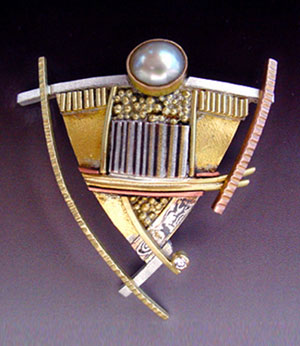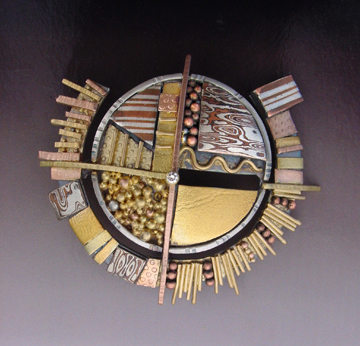
John Bahr and Lynda Fullerton like to learn new things. Having designed jewelry together since 1990, they had the basics down a while ago. But they get bored easily so they developed an annual tradition. As each year draws to a close, they put their heads together and come up with something both want to learn.
For creative spark, they invite artist friends over for a Christmas gathering at their home in San Gregorio, CA, and ask them to bring something they’re working on. “Everybody is exploring new stuff,” Fullerton says. “You get inspiration from your friends.”
Once they agree on the next challenge, the couple sets about mastering it. Over the years they’ve tried roller printing, press forming, stone cutting, colored patinas and enameling.
At the end of 1999, they decided to try mokume gane. They had no idea what they were getting into. In retrospect, that was probably a blessing.
Mokume gane (pronounced “mukoomay gahnay”), the Japanese technique of stacking and fusing different metals, is far more complicated than it appears. As many as 20-40 layers are fused into a solid sheet in a kiln, then cooled, hammered to a quarter-inch sheet, and sliced. The process is repeated to get the desired patterns, which range from stripes to a swirling wood grain, depending how you slice it. (Cutting straight down produces stripes; diagonal cuts produce a wood grain; and drilling holes creates circular patterns.)
 The trickiest step, they discovered, is the firing. Every metal has a different melting temperature and the Fullerton-Bahrs use several, including green and white gold, palladium and shakudo (a gold-copper alloy).
The trickiest step, they discovered, is the firing. Every metal has a different melting temperature and the Fullerton-Bahrs use several, including green and white gold, palladium and shakudo (a gold-copper alloy).
“When you use as many different metals as we do, the problem is that a eutectic alloy can form,” Fullerton says. “Two metals come together and form a new alloy that may melt at a lower temperature than either of the two original metals. We’ve ruined a few pieces that way.”
A year after they took it on, they had made considerable progress and mokume gane had become an integral part of their jewelry, but they were a long way from mastery. So they decided to put the annual tradition on hold for a while. They had found, for them, the ultimate challenge and an endless source of fascination.
“We will probably study this to our graves,” Fullerton says, laughing. “We got addicted to it. We’re still developing the technique, and probably always will be.”
To see more of their mokume gane creations, visit the Fullerton-Bahr Jewelry site.

